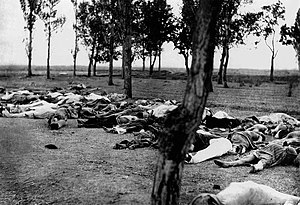This is an old revision of this page, as edited by GenoV84 (talk | contribs) at 00:59, 21 December 2022 (Reinserted infobox.). The present address (URL) is a permanent link to this revision, which may differ significantly from the current revision.
Revision as of 00:59, 21 December 2022 by GenoV84 (talk | contribs) (Reinserted infobox.)(diff) ← Previous revision | Latest revision (diff) | Newer revision → (diff) 1913–1924 Armenian, Greek, and Assyrian genocides| Late Ottoman genocides | |
|---|---|
| Part of the Dissolution of the Ottoman Empire and World War I | |
 Picture showing Armenians killed during the Armenian genocide which is argued to be part of wider genocidal events in late Ottoman history. Picture showing Armenians killed during the Armenian genocide which is argued to be part of wider genocidal events in late Ottoman history. | |
| Location | Ottoman Empire |
| Date | 1913–1922 (disputed), with earlier and later episodes of mass violence |
| Target | Main: Armenians, Greeks and Assyrians Minor: Bulgarians, Kurds, Arabs and Jews |
| Attack type | Genocide, ethnic cleansing, deportation, death march, pogrom |
| Deaths | 600,000 to 1,500,000 Armenians, 300,000 to 900,000 Greeks, 250,000 Syriac Christians |
| Perpetrators | Young Turks (Committee of Union and Progress) Turkish National Movement |
The late Ottoman genocides is a historiographical theory which sees the concurrent Armenian, Greek, and Assyrian genocides that occurred during the 1910s–1920s as parts of a single event rather than separate events which were initiated by the Young Turks. Although some sources, including The Thirty-Year Genocide by the historians Benny Morris and Dror Ze'evi, characterize this event as a genocide of Christians, others such as those written by the historians Dominik J. Schaller and Jürgen Zimmerer [de] contend that such an approach "ignores the Young Turks' massive violence against non-Christians", in particular against Muslim Kurds.
The historian and sociologist Uğur Ümit Üngör states that the mass violence and enslavement which occurred in the late Ottoman Empire and its successor state includes—but is not limited to—the persecutions of Muslims during the Ottoman contraction in the 19th and early 20th century, the Adana massacre of Armenians in 1909, the Greek genocide (1913–1922), the Assyrian genocide (1914–1924), the Armenian genocide (1915–1917), the 1921 Koçgiri massacres of Kurdish rebels, "the mass violence against Kurds from the 1925 Sheikh Said conflict to the 1938 Dersim massacre", the 1934 Thrace pogroms against Jews, and the 1955 Istanbul pogrom against Greeks and Armenians. Other scholars sometimes also include the earlier Hamidian massacres of Armenians in the 1890s or the deportations of Kurds between 1916 and 1934.
According to the journalist Thomas de Waal, there is a lack of a work similar to historian Timothy Snyder's Bloodlands that attempts to cover all of the mass violence in Anatolia and the Caucasus between 1914 and 1921. De Waal suggests that while "the genocide of 1915–1916 would stand out as the biggest atrocity of this period... would also establish a context that would allow others to come to terms with what happened and why, and also pay homage to the many Muslims who died tragically in this era".
References
- ^ Morris, Benny; Ze'evi, Dror (4 November 2021). "Then Came the Chance the Turks Have Been Waiting For: To Get Rid of Christians Once and for All". Haaretz. Tel Aviv. Archived from the original on 4 November 2021. Retrieved 5 November 2021.
- Shirinian, George N. (2017). Genocide in the Ottoman Empire: Armenians, Assyrians, and Greeks, 1913–1923. Berghahn Books. ISBN 978-1-78533-433-7.
- Morris, Benny; Ze'evi, Dror (2019). The Thirty-Year Genocide: Turkey's Destruction of Its Christian Minorities, 1894–1924. Cambridge, Massachusetts: Harvard University Press. pp. 3–5. ISBN 978-0-674-24008-7.
- Gutman, David (2019). "The thirty year genocide: Turkey's destruction of its Christian minorities, 1894–1924". Turkish Studies. 21. Routledge: 1–3. doi:10.1080/14683849.2019.1644170. S2CID 201424062.
- Schaller, Dominik J.; Zimmerer, Jürgen (2008). "Late Ottoman genocides: the dissolution of the Ottoman Empire and Young Turkish population and extermination policies—introduction". Journal of Genocide Research. 10 (1): 7–14. doi:10.1080/14623520801950820. S2CID 71515470.
- Schaller, Dominik J.; Zimmerer, Jürgen, eds. (2013). Late Ottoman Genocides: The dissolution of the Ottoman Empire and Young Turkish population and extermination policies. Routledge. ISBN 978-1-317-99045-1.
- Akçam, Taner (2011). The Young Turks' Crime Against Humanity. Princeton University Press.
- üngör, Ug˘ur ümit (2008). "Seeing like a nation-state: Young Turk social engineering in Eastern Turkey, 1913–50". Journal of Genocide Research. 10 (1): 15–39. doi:10.1080/14623520701850278. S2CID 71551858.
- Deringil, Selim; Adjemian, Boris; Nichanian, Mikaël (2018). "Mass Violence in the Late Ottoman Empire: A Discussion". Études Arméniennes Contemporaines (11): 95–104. doi:10.4000/eac.1803. S2CID 165468004.
- de Waal, Thomas (2015). Great Catastrophe: Armenians and Turks in the Shadow of Genocide. Oxford University Press. p. 254. ISBN 978-0-19-935069-8.
Bibliography
- Roshwald, Aviel (2013). "Part II. The Emergence of Nationalism: Politics and Power – Nationalism in the Middle East, 1876–1945". In Breuilly, John (ed.). The Oxford Handbook of the History of Nationalism. Oxford and New York: Oxford University Press. pp. 220–241. doi:10.1093/oxfordhb/9780199209194.013.0011. ISBN 9780191750304.